When it comes to sports betting, understanding the intricacies of different bet types can significantly impact your profitability, especially when you have an edge. Two popular types of bets are singles and multiples. While singles involve betting on a single outcome, multiples combine several selections into one bet. This blog post will explore the benefits of betting on multiples over singles when you have an edge, and explain the differences between various multiple and system bet options, such as patents, Yankees, and Lucky 15s. We’ll also discuss the impact on expected value (EV) and variance.

Benefits of Betting on Multiples
Increased Potential Returns
Higher Multiplicative Payouts: The primary appeal of multiples is the potential for higher returns due to the compounding nature of odds. For example, a treble (three selections) can offer significantly higher returns than three individual single bets. This should be treated carefully with an understanding of the potential for lengthy losing runs when combining high odds with high variance options.
Leveraging an Edge
If you have an edge, the multiplicative nature of multiples can amplify the advantage. For instance, a 5% edge on a single bet might not be as lucrative as a combined edge on a well-structured multiple.
Psychological and Strategic Benefits
Chasing Larger Wins
Multiples provide the thrill of chasing larger payouts with smaller stakes, appealing to bettors looking for substantial wins. This is something to be aware of to avoid falling into the trap that befalls so many gamblers.
Diverse Outcome Exposure
System Bets can spread risk across different events, which can be advantageous if you have insights across multiple sports or markets.
Differences Between Multiples and System Bets
Multiples
Multiples, also known as accumulators or parlays, are bets that combine multiple selections into one wager. All selections must win for the bet to pay out. Common types include:
- Double: Two selections.
- Treble: Three selections.
- Accumulator: Four or more selections.
System Bets
System bets consist of multiple combinations of singles and accumulators. Unlike regular multiples, system bets do not require all selections to win for a return. Popular system bets include:
- Patent: Seven bets covering three selections (three singles, three doubles, one treble).
- Yankee: Eleven bets covering four selections (six doubles, four trebles, one fourfold accumulator).
- Lucky 15: Fifteen bets covering four selections (four singles, six doubles, four trebles, one fourfold accumulator).
- Heinz: Fifty-seven bets covering six selections (15 doubles, 20 trebles, 15 fourfold accumulators, 6 fivefold accumulators, one sixfold accumulator).
Expected Value (EV) and Variance
Expected Value (EV)
Betting on singles usually provides more consistent EV since each bet is independent. However, when you have an edge, multiples can exponentially increase EV by leveraging the compounded nature of odds.
Variance
Multiples inherently carry higher variance due to the all-or-nothing nature. System bets can mitigate variance by allowing partial payouts even if not all selections win. This balance between risk and reward can be beneficial, depending on the bettor’s risk tolerance.
Choosing the Right Strategy
Betting on multiples can be a powerful strategy when you have an edge, offering the potential for amplified returns. However, it’s crucial to consider the trade-off between expected value and variance. System bets, while reducing variance, may also lower potential returns compared to pure multiples. Therefore, understanding your risk tolerance and betting objectives is key to selecting the appropriate betting strategy.
Multiples and system bets can be valuable tools in a bettor’s arsenal, particularly when combined with a well-researched or mathematically proven edge such as those avaialable through using the BookieBashin tools and trackers. By leveraging these options wisely, bettors can enhance their betting experience and potentially increase their profitability.
Making use of BB Tools
We have a powerful System Bets Calculator that you can utilise to analyse the impact of different bet types on your EV%.
Here are examples of singles versus doubles and how the EV% is affected based on 10% edge win only bets:
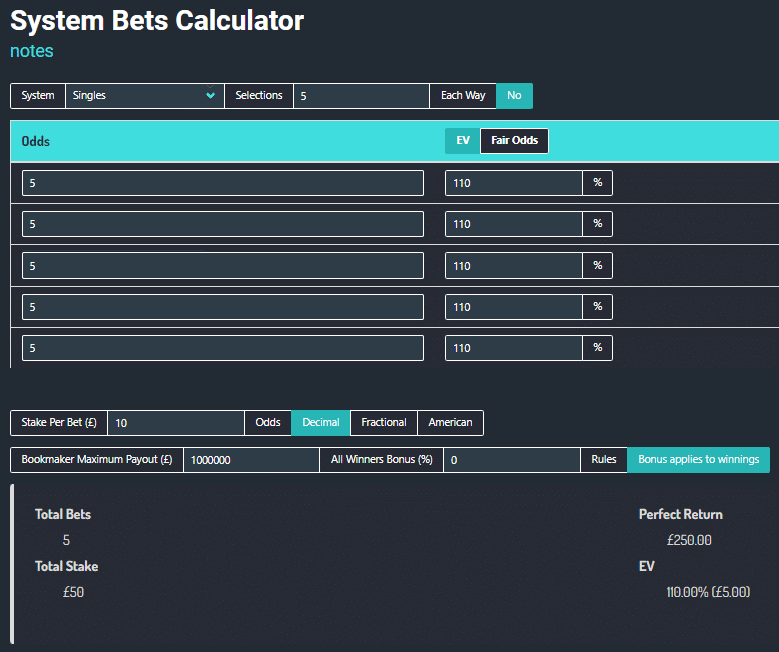
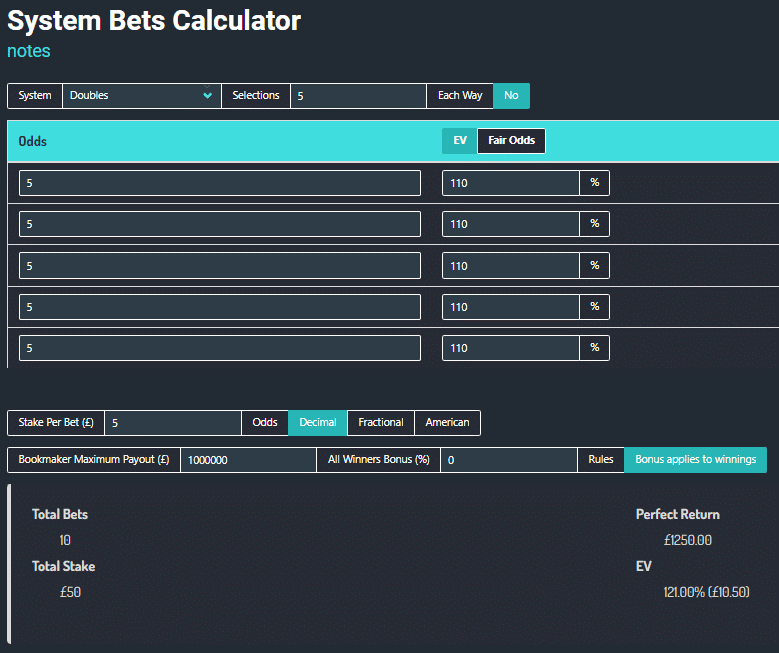
Analysis of Singles vs. Doubles Betting
Singles Betting
- Total Bets: 5
- Stake per Bet: £10
- Total Stake: £50
- Perfect Return: £250
- Expected Value (EV): 110% (£5.00)
In singles betting, each bet is placed on an individual selection. The total potential return is derived from the sum of all individual bets. The EV of 110% indicates that for every £100 staked, there is an expected profit of £10, given the edge.
Doubles Betting
- Total Bets: 10
- Stake per Bet: £5
- Total Stake: £50
- Perfect Return: £1,250
- Expected Value (EV): 121% (£10.50)
In doubles betting, combinations of two selections are formed. The total potential return significantly increases due to the multiplicative effect of combining odds. The EV of 121% is higher than singles, suggesting an increased expected profit of £21 per £100 staked.
Key Insights
Increased Expected Value (EV):
- The switch from singles to doubles increases the EV from 110% to 121%. This increase in EV highlights that when you have an edge, leveraging it through multiples can yield a higher return on investment. The compounding effect of combining selections amplifies the profitability.
Higher Variance:
- While the potential returns are higher in doubles, the variance also increases. This is because all combinations in a double must win for a payout, unlike singles, where each bet is independent. Therefore, doubles can lead to larger swings in the bankroll, both positively and negatively.
Risk and Reward:
- The increased EV in doubles comes with the trade-off of higher risk. Bettors need to weigh their tolerance for risk against the potential for greater rewards. For those comfortable with higher variance, doubles can be a more lucrative strategy.
Stake Efficiency:
- Doubling the number of bets in doubles while maintaining the total stake showcases efficient bankroll utilisation. This efficiency allows for exposure to more potential outcomes with the same amount of capital.
The comparison between singles and doubles demonstrates that leveraging an edge in multiples can significantly enhance EV, albeit with increased risk. Bettors should consider their risk tolerance and objectives when deciding between singles and multiples. For those looking to maximise returns, doubles offer a compelling option, provided they are prepared for the accompanying variance.
Compound EV further!
We can see that doubles increase our potential returns, how about we take this further and look at some more exotic or risqué bets. The system bets calculator can deal with a number of different bet types. If we use similar examples we can see the benefits to our expected returns with an assumed 10% edge on each bet:
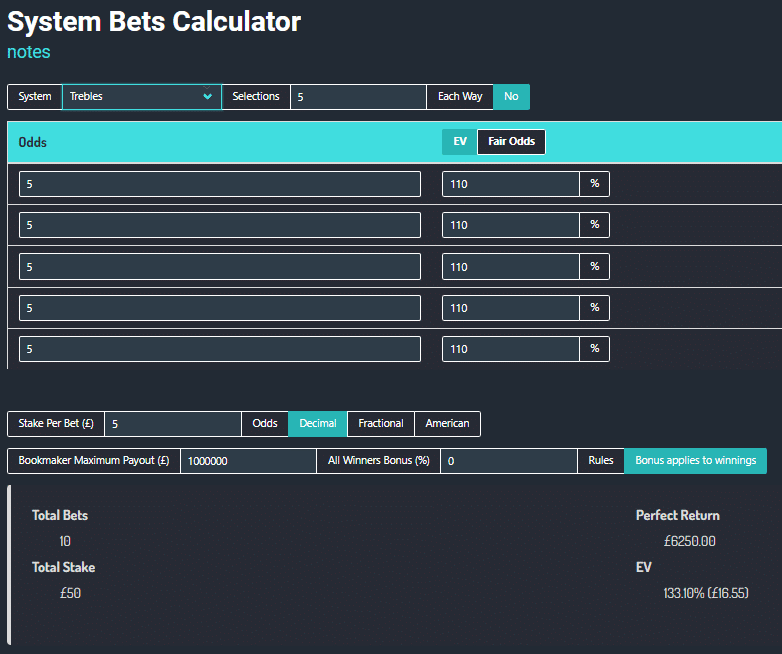
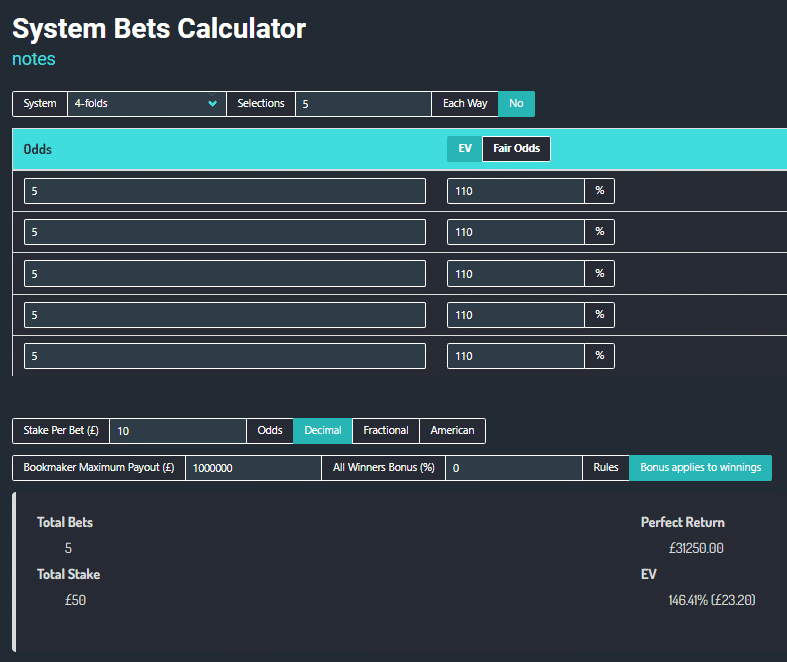
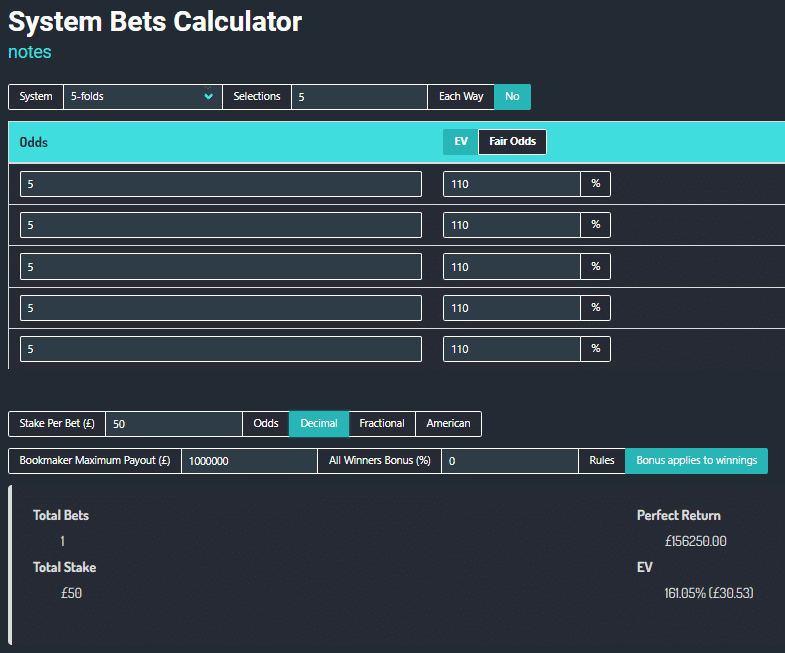
The pattern is clear, so why don’t we just bet on five-folds. or even ten-folds?!
The answer is variance. We would have to wait a long time for a ten-fold to come in, even if we were betting at evens, and if we are betting at longer odds our lifetimes may not come close to being long enough for the variance to flatten out.
We also have a variance model here that you can plug your numbers into and see the liklihood of your returns over a specific number of bets.
Options for managing our bankrolls
So…we would like to take advantage of compounding whilst not betting on odds that are so long that we die before the big one comes in. We could find some middle ground using doubles or trebles, or we could look at the various system bets that are available to us.
Plugging some of these into the system bets calculator gives us the following outcomes:
Lucky 15
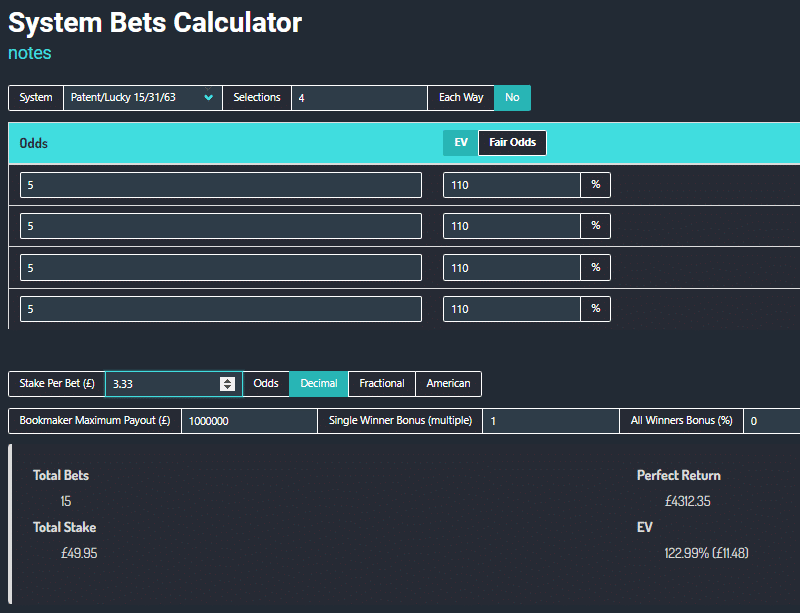
Lucky 31
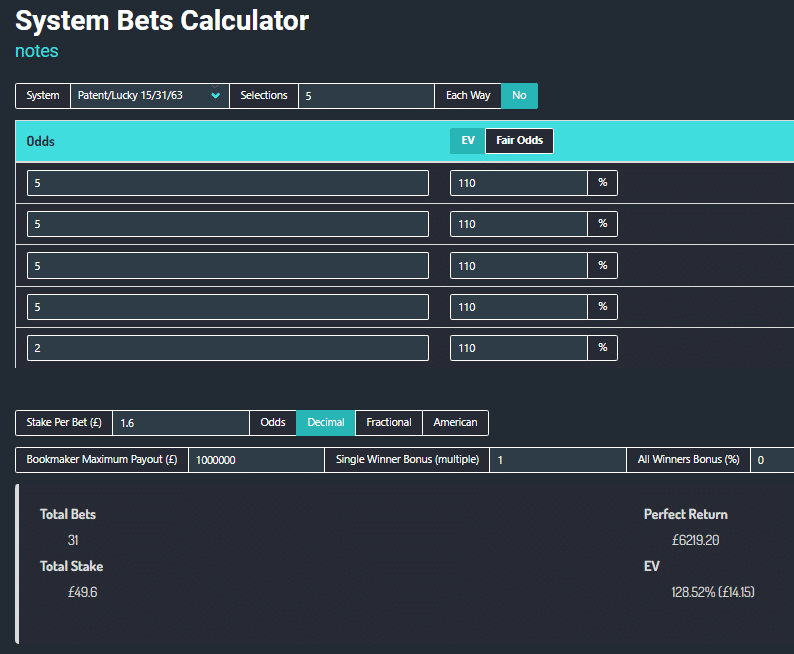
Yankee
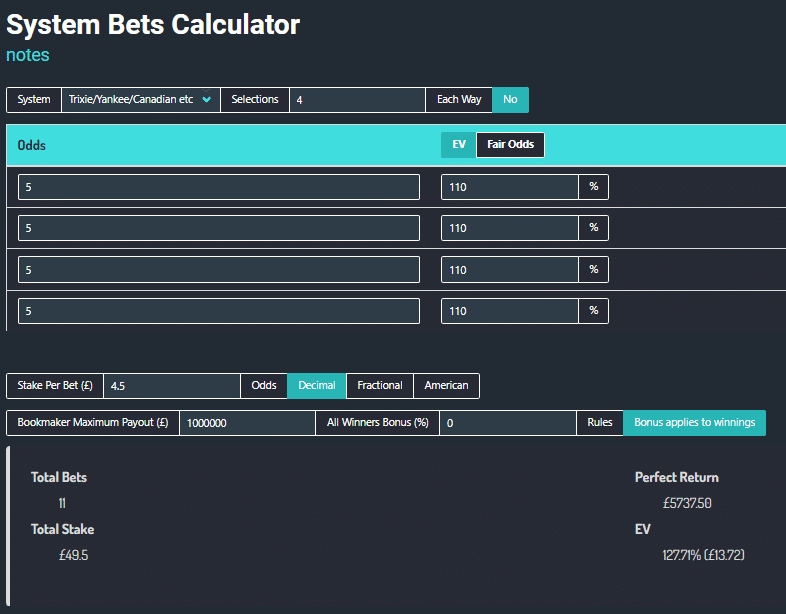
But which one do I use?
Each have their own benefits and can be utilised at different times depending on the number of selections available and whether there are any beneficial concessions avaialble from the bookmakers.
For example, the Lucky 31 consists of 31 bets covering five selections (five singles, ten doubles, ten trebles, five fourfold accumulators, and one fivefold accumulator). The high number of combinations provides multiple ways to profit, even if not all selections win, thus reducing variance. The EV of 128.52% indicates a healthy expected profit margin. Look out for bookmaker concessions as these can really make a difference.
Using the 10% edge on each bet this is how the bet types rank in terms of EV%. Only you can decide what works best for you when balancing between EV% and variance.
Combining the system bets calculator with the variance model will help to put you in the picture and take control of your bet types.
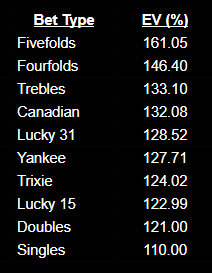
Another advantage
Bookies expect sharp bettors to bet on singles and recreational gamblers to use multiples and system bets. You may find your account stays open for longer before the inevitable gubbing notification arrives in your inbox.
Summary and Considerations
Variance and EV Relationship:
- Higher variance bets, such as fourfolds and fivefolds, offer higher EV due to the all-or-nothing nature of these bets. However, they require all selections to win, making them riskier.
- Lower variance bets, like singles or the doubles, offer more consistent returns. These bets typically have a lower EV but offer reduced risk.
Strategic Implications:
- High-Risk Tolerance: Bettors willing to take on higher risk for potentially larger payouts may prefer fivefolds, taking advantage of the highest EV but they should be wary if the average odds are high!
- Moderate-Risk Strategy: For those looking to balance risk and return, trebles or trixies offer a middle ground with decent EV and manageable variance.
- Conservative Approach: Bettors preferring consistent returns with lower risk may favour the Lucky 31, as it offers numerous ways to profit even with a few losses.
Stake Efficiency:
- The effective use of a betting bankroll is crucial. Allocating smaller stakes across multiple combinations, as in the Lucky 15’s or 31’s, can provide diversification and reduce the impact of losing streaks.
Overall, selecting the appropriate system bet depends on individual risk tolerance, betting objectives, and the confidence in the selections made. By understanding the trade-offs between EV and variance, bettors can optimise their strategy to align with their goals.